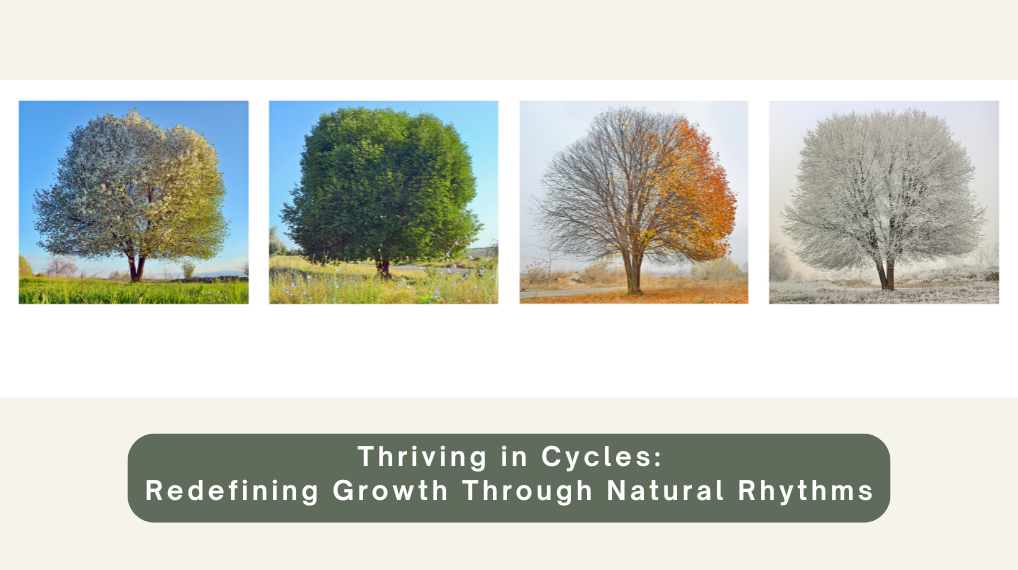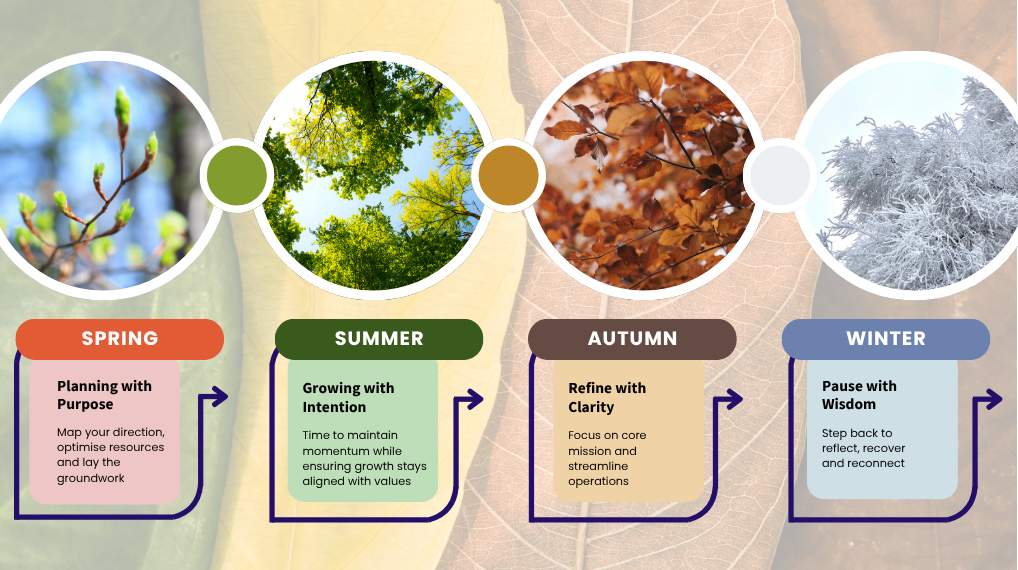Rooted Leadership: What Business Can Learn from the Natural World
The modern business landscape pushes for relentless acceleration, propelled by an undercurrent of continuous innovation, rapid scaling, and an ‘always-on’ operational mindset. Leaders are under pressure to deliver continuous growth and chase new milestones which often inadvertently cultivate a “hustle” culture. However, this pursuit of acceleration exacts a heavy toll: employee burnout, resource depletion, and a struggle for sustained relevance. We have collectively fallen for the myth of endless productivity, believing that the more efficient our processes, the more work we can (and should) undertake. This mindset traps us in a loop of constant doing, neglecting the essential value of pause, renewal, and strategic timing. In contrast, the natural world operates on entirely different principles. Seasons shift. Ecosystems rest, renew, and regenerate in cycles. Nature challenges our obsession with output and offers a different pace: one where growth comes in waves and sustainability is built on balance.
Businesses, too, exhibit their own cyclical patterns and seasonal demand fluctuations. Predictable temporal cycles, like holiday peaks or off-season periods, can be anticipated and planned for. While we cannot control natural elements like the weather and environmental shifts, we can certainly plan for their impact, transforming them into clear opportunities to pivot and adapt. The escalating impact of environmental disasters, from California’s wildfires to global weather extremes, powerfully demonstrates nature’s ability to impose significant costs and unforeseen challenges on businesses worldwide. Beyond environmental factors, consumer behavior is also profoundly influenced by community and cultural events. Think of the market shifts seen during global sporting championships like Formula 1, popular music festivals, or significant religious observances.
By recognising these patterns, businesses can move away from reactionary strategies and toward more regenerative and intentional growth. This article explores how leaders can redefine growth, build organisational resilience, and lead regeneratively by embracing nature’s profound wisdom, learning from seasonal timing, the strength of deep roots, and the critical importance of rest. What if our organisations took nature’s lead? Slower, more intentional growth may well be the only path to long-term success. It’s time to reconsider our trajectory, choosing deliberate and clear progress over the desire to move as fast as possible.

Spring: Planting Seeds That Reflect Purpose
Spring in nature embodies intentional beginnings. It is a time when seeds are planted, conditions are assessed, and careful preparation takes place. It’s not expecting immediate returns, but about establishing proper foundations for long-term growth. This season underscores the value of preparation and laying the groundwork. For business leaders, this parallels a time for strategic visioning, meticulous planning, and resource allocation. During the “spring” phase of a growth cycle, leaders must actively engage in preparation. This means intently scanning the broader environment for emerging market trends and community shifts, then deploying resources where they’ll have the greatest long-term impact. It’s a critical time for leaders to pinpoint new growth avenues, initiate new plans, and improve efficiency of key processes. Success in this season comes from planning with foresight, not urgency.
Key lessons during this phase:
1. Optimise Resource Use
Predictable seasonal trends in the industry allow businesses to allocate manpower, inventory, and operations more efficiently. Planning ahead avoids inefficiency during downturns while maintaining full capacity for critical peak periods.
2. Planning Marketing Campaigns & Product Launches
Anticipate high-demand windows and launch products or campaigns just ahead of them. This increases traction, drives conversions, and keeps your brand visible when engagement is at its peak.
3. Align with Community Events
Tap into festivals, holidays, and local traditions by syncing your offerings and promotions with cultural or community events. These events create opportunities to connect with your customer base, strengthening community ties and brand relevance.
Summer: Cultivating Growth Without Losing Ground
Summer signifies full bloom, when the seeds sown in spring yield visible results. It’s a time of accelerated growth and plentiful resources, yet it demands resilience as ecosystems contend with intense conditions like heatwaves and sudden environmental stressors. For businesses, summer mirrors this dynamic: it’s a phase characterized by high activity, surging demand, and operational intensity. While this phase often represents a period of significant revenue and market capture, this flourishing growth inherently brings its own set of vulnerabilities. This makes it a critical time for leaders to exercise caution, actively safeguarding long-term stability by preparing for unforeseen circumstances. To truly thrive during this season, leaders must balance growth with preparedness.
Key lessons during this phase:
1. Market Diversification & Product Innovation
This period is ideal for deepening customer engagement by developing new experiences, products or offerings. Diversifying can help capture more value from existing audiences while reaching new ones.
2. Operational Agility & Scalability
Growth require flexibility and scale. To meet escalating demand without compromising quality or customer experience, leaders must ensure operations scale seamlessly by investing in technology, forming strategic partnerships, and maintaining strong customer feedback loops.
3. Cultivating a Growth Mindset
By prioritising continuous learning, through investment in training and skill development, businesses can cultivate a robust growth culture, ensuring their teams consistently strengthen their capabilities, even during peak performance.
Autumn: Embracing Cycles and Learning to Let Go
Autumn in nature signifies a crucial and deliberate period of letting go. Trees shed their leaves to conserve energy, meticulously preparing for the deep renewal of winter. For business leaders, this period is an opportunity to let go of outdated methods, cut back on underperforming assets, and streamline inefficient processes, in order to reallocate resources for meaningful regeneration. Just as trees instinctively release what no longer serves their long-term health, companies must strategically and systematically evaluate their entire operational landscape. This rigorous assessment aims to identify operational inefficiencies, unprofitable ventures, and eliminate any redundancies that drain financial resources and impede sustainable growth. Sometimes businesses need to simplify and focus on the essentials to build a stronger business that can grow in the long run.
Key lessons during this phase:
1. Strategic Reflection and Evaluation
Leaders should initiate a comprehensive internal audit, critically assessing current initiatives, processes, and investments to clearly identify value-driving elements.
2. Streamlining for Efficiency
Leaders should strategically divest from initiatives or processes that no longer align with their core mission. By making these cuts, businesses can free up resources, create space for new ideas, and build greater resilience.
3. Embrace Changes
Leaders must actively embrace change and foster an organisational culture that is open and responsive to evolving market conditions, regulatory shifts, and technological advancements.
Winter: Pausing to Reflect, Reassess, and Reimagine
Winter is a time of stillness and deep restoration. For businesses, this seasonal metaphor extends an invitation to deliberately slow down, engage in deep reflection, and initiate strategic regeneration. In a landscape obsessed with relentless productivity and the constant desire to do more, it’s easy to overlook the power of pausing and embracing stillness. By intentionally allowing time for rest and renewal, organisations do more than protect current performance and employee health. They create space for foresight, innovation, and the growth of resilience and adaptability. Embracing this period of rest is a proactive investment in long-term vitality, preparing the business to emerge stronger for the demands of the next growth cycle.
Key lessons during this phase:
1. Strategic Downtime and Renewal
This period offers businesses a critical opportunity for intentional pause and reinvestment. Taking a deliberate break creates the ideal conditions for generating fresh ideas and engaging in creative problem-solving. Leaders should leverage this time to recalibrate and refocus for the next growth cycle.
2. Product & Service Innovation
This could be a good time for experimentation since businesses can dedicate resources to developing new products or exploring novel concepts without the pressure of having high operational volumes.
3. Prioritising Employee Well-being
Leaders should actively prioritise and invest in their team’s well-being. This extends beyond traditional benefits to include supporting team-building activities and engaging staff in strategic planning sessions. In this way, organisations ensure their teams return to peak performance with renewed energy and sharpened focus.
Conclusion: Leading in Harmony with Natural Rhythms

Each season holds vital lessons for leaders:
- Spring reminds us that success begins with thoughtful planning.
- Summer teaches the value of sustaining and managing growth.
- Autumn invites us to evaluate and release what no longer benefits us.
- Winter underscores the necessity of rest and patience.
Together, these seasonal cycles in nature provide a critical insight: growth is cyclical, and it is not a constant upward trajectory. Business leaders who integrate this understanding into their strategy gain a significant advantage and they can approach complexity with increased agility and a long-term perspective. Ultimately, tuning into natural patterns and rhythms can help us make better decisions rather than endlessly chasing productivity. What if growth and productivity was less about acceleration and more about alignment? Less about control, and more about collaboration. By aligning our organisations with nature’s seasons and wisdom, we can begin to cultivate more resilient and regenerative systems capable of thriving in an unpredictable world.
Stay ahead with exclusive insights! Sign up for our mailing list and never miss an article. Be the first to discover inspiring stories, valuable insights and expert tips – straight to your inbox!




